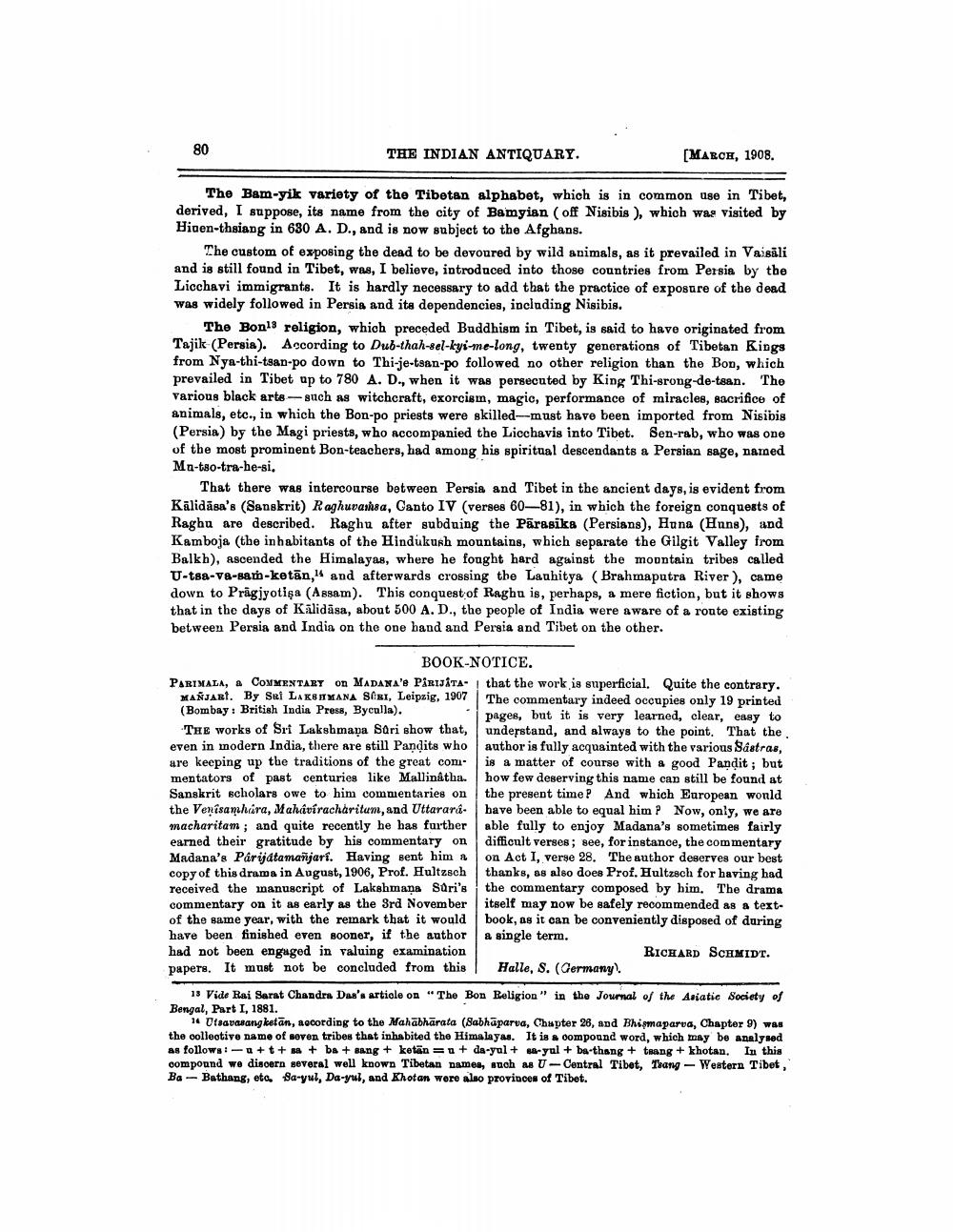________________
80
THE INDIAN ANTIQUARY.
[MARCH, 1908.
The Bam-yik variety of the Tibetan alphabet, which is in common use in Tibet, derived, I suppose, its name from the city of Bamyian (off Nisibis ), which was visited by Hiuen-thsiang in 680 A. D., and is now subject to the Afghans.
The custom of exposing the dead to be devoured by wild animals, as it prevailed in Vaisāli and is still found in Tibet, was, I believe, introduced into those countries from Persia by the Licchavi immigrants. It is hardly necessary to add that the practice of exposure of the dead was widely followed in Persia and its dependencies, including Nisibis.
The Bonl8 religion, which preceded Buddhism in Tibet, is said to have originated from Tajik (Persia). According to Dub-thah-sel-kyi-me-long, twenty generations of Tibetan Rings from Nya-thi-tsan-po down to Thi-je-tsan-po followed no other religion than the Bon, which prevailed in Tibet up to 780 A. D., when it was persecuted by King Thi-srong-de-tsan. The various black arts--such as witchcraft, exorcism, magic, performance of miracles, sacrifice of animals, etc., in which the Bon-po priests were skilled-must have been imported from Nisibis (Persia) by the Magi priests, who accompanied the Licchavis into Tibet. Sen-rab, who was one of the most prominent Bon-teachers, had among his spiritual descendants a Persian sage, named Ma-tso-tra-he-si.
That there was intercourse between Persia and Tibet in the ancient days, is evident from Kālidāsa's (Sanskrit) Raghuvashsa, Canto IV (verses 60-81), in which the foreign conquests of Raghu are described. Raghu after subduing the Pārasika (Persians), Huna (Hans), and Kamboja (the inhabitants of the Hindukush mountains, which separate the Gilgit Valley from Balkh), ascended the Himalayas, where he fought hard against the mountain tribes called U-tsa-va-sa-ketān, and afterwards crossing the Lauhitya (Brahmaputra River), came down to Prāgiyotişa (Assam). This conquest of Raghu is, perhaps, a mere fiction, but it shows that in the days of Kalidasa, about 500 A.D., the people of India were aware of a route existing between Persia and India on the one hand and Pergia and Tibet on the other.
BOOK-NOTICE. PARIMALA, A COMMENTARY ON MADANA'S PARIJITA- that the work is superficial. Quite the contrary. MAÑARÍ. By Sei LAKBIYANA SOBI, Leipzig, 1907 The commentary indeed occupies only 19 printed (Bombay: British India Press, Byculla).
pages, but it is very learned, clear, easy to The works of Sri Lakshmaṇa Sari show that, understand, and always to the point. That the even in modern India, there are still Pandits who author is fully acquainted with the various Sastras, are keeping up the traditions of the great com. is a matter of course with a good Pandit ; but mentators of past centuries like Mallinatha. | how few deserving this name can still be found at Sanskrit scholars owe to him commentaries on the present time? And which European wonld the Venisamhára, Mahavíracharitum, and Uttarari. bave been able to equal him ? Now, only, we are macharitam; and quite recently he has further able fully to enjoy Madana's sometimes fairly earned their gratitude by his commentary on difficult verses; see, for instance, the commentary Madana's Parijatamañjari. Having sent him a on Act I, verse 28. The author deserves our best copy of this drama in August, 1906, Prof. Hultzsch thanks, as also does Prof. Hultzsch for having had received the manuscript of Lakshmana Sari's the commentary composed by him. The drama commentary on it as early as the 3rd November itself may now be safely recommended as a textof the same year, with the remark that it would book, as it can be conveniently disposed of during have been finished even sooner, if the author a single term. had not been engaged in valuing examination
RICHARD SCHMIDr. papers. It must not be concluded from this Halle, S. (Germany
18 Vide Rai Sarat Chandra Dan's article on "The Bon Religion" in the Journal of the Asiatic Society of Bengal, Part I, 1881.
14 Utsavarang ketān, according to the Mahābhārata (Sabhāparva, Chapter 26, and Bhi maparva, Chapter 9) was the colleotive name of seven tribes that inhabited the Himalayas. It is a compound word, which may be analysed as follows:- + + + + ba + sang + ketän = 1 + da-yal + 48-yul + ba-thang + trang + khotan. In this compound we discern several well known Tibetan names, such as U-Central Tibet, Tsang - Western Tibet, Ba - Bathang, etc. Sa-yul, Da-yul, and Khotan wore also provinces of Tibet.




